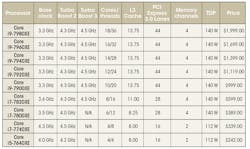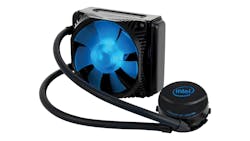Intel had a pair of announcements that target the high-end desktop (HEDT) market with its Core series of microprocessors. The HEDT market is small but lucrative where gamers, multimedia content creators, and high-end workstation users demand maximum performance and are willing to pay the price. These systems typically pack in the latest GPU cards and high-performance storage like Intel’s Optane memory.
The first is the extension of the Core i7 line with the X-Series processor family, also known as Skylake-X. The second is an even higher end platform appropriately named Core i9. The X-Series architecture extends from the Core i5 through the Core i9 Extreme (Fig. 1). The chips use Intel’s 14-nm tri-gate 3D transistor technology.
The new X-series Core family scales from four to 18 cores (Fig. 2). The chips plug into a new LGA 2066 socket and employ the latest Turbo Boost Max Technology 3.0. The Intel X2999 chipset provides enhanced I/O capabilities to the family. There is a 15% single-thread performance boost and a 10% multithread performance boost, so the main advantage comes in other areas like more cores and more PCI Express Gen 3 lanes, as well as Thunderbolt 3 support.
The chips support the latest Intel AVX-512 instruction set. The 512-bit SIMD support doubles that of the earlier AVX-256 support. The wider data bus is very useful for many applications and the instruction set supports a range of floating point formats.
Intel has rebalanced the Smart Cache hierarchy, but shifted shared L3 memory down into the L2 memory that is dedicated to a core. Prior chips used a 256 Kbyte L2 cache where the new cores deliver four times this amount. Of course, having one megabyte of L2 cache improves the hit rate for each core, but it also reduces the size of the L3 cache. Overall, for desktop applications, this approach proves to be more effective.
The increase in the number of PCI Express lanes at the top end is needed to accommodate up to two x16 or four x8 PCI Express-based GPUs. This targets the 12K gaming and live streaming applications. Yes, that is 12K, as in the current 4K that large-screen HDTVs now deliver.
The Intel X2999 chipset adds up to 24 PCI Express Gen 3 lanes, eight SATA 3.0 ports, and 10 USB 3.0 ports to the mix. There is also an I219 Ethernet connection.
By the way, the X-series is unlocked to allow for overclocking. This requires improved cooling to make sure the chips do no overheat but liquid cooling solutions are quite common in this space. In fact, Intel now has its own offering, the TS13X (Fig. 3).
The midrange TS13X has a 120- by 120-mm fan that has a noise level of 21 dBA at 800 RPM and 35 dBA at 2,200 RPM. The sealed system employs propylene glycol. The package is priced under $100.
Users can take advantage of the Extreme Tuning Utility (XTU), as well as the Extreme Memory Profile 2.0 support. Of course, overclocking is done at the user’s expense.
The X-series will have some competition, however, courtesy of AMD’s recently announced Threadripper-based Ryzen processors.





